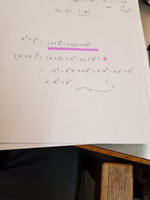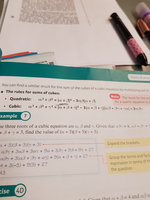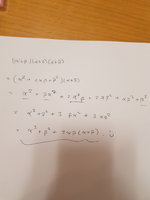I know the equation for sum of two cubes (see the equation next to asterix). I simply cant get the equation on the right. see purple underlined equation. It does say that the result of the sum of the cubes for a quadratic is not required, but i think it relates to the cubic sum of cubes. I dont see where the 3 come from.
Rules of sum of cubes
- Thread starter Sonal7
- Start date
I know the equation for sum of two cubes (see the equation next to asterix).
Dr.Peterson
Elite Member
- Joined
- Nov 12, 2017
- Messages
- 16,809
I'm not sure what you are trying to do. The book gives formulas involving a sum of cubes, but nowhere does it suggest you should use the factorization for a sum of cubes to derive them, which is what this formula is. It was mentioned in post #3 probably just because that's what we often think of when we hear "sum of cubes". What you did in post #6 is undoubtedly how they expect you to see the fact they show, as they tell you to do what Jomo said in post #4.
What you did in post #8 is to prove that the factorization is correct. It is not relevant to your problem.
It appears that you are expected to memorize the formulas they show (after convincing yourself that they are true), and they are useful for certain kinds of problems. I have to say I have never seen those facts given as "rules", though. If I find them useful, I derive them.
What you did in post #8 is to prove that the factorization is correct. It is not relevant to your problem.
It appears that you are expected to memorize the formulas they show (after convincing yourself that they are true), and they are useful for certain kinds of problems. I have to say I have never seen those facts given as "rules", though. If I find them useful, I derive them.
I am unhappy with that aspect of the book in general. I think once you use the formulae a few times, you are unlikely to forget them. One is bound to use short cuts that as one become more advanced mathematician. Yes thats exactly right, the statement 'sum of the cubes' threw me in all kinds of direction. I think it doesnt take very long to do derive the formula should one forget, its also more fun too. Sorry to bore people with this trivial problem.
topsquark
Senior Member
- Joined
- Aug 27, 2012
- Messages
- 2,370
There seems to be a problem here and I don't know why it's written out. Your given solution assumes that α3+β3=(α+β)3. This is not true in general.
The equation where this happens is the one with the pink asterisk:
(α+β)3=(α+β)(α2−αβ+β2) This equation is not true.
(α+β)3=(α+β)(α2+2αβ+β2) is true.
-Dan
The equation where this happens is the one with the pink asterisk:
(α+β)3=(α+β)(α2−αβ+β2) This equation is not true.
(α+β)3=(α+β)(α2+2αβ+β2) is true.
-Dan
Yes you are right. Its a mistake. Its suppose to be the sum of the cubes formula, rather than the cube of the sums which I have accidently written.There seems to be a problem here and I don't know why it's written out. Your given solution assumes that α3+β3=(α+β)3. This is not true in general.
The equation where this happens is the one with the pink asterisk:
(α+β)3=(α+β)(α2−αβ+β2) This equation is not true.
(α+β)3=(α+β)(α2+2αβ+β2) is true.
-Dan
First, this is all wrong.[MATH]a^3+b^3=(a+b)(a^2-2ab+b^2)[/MATH][MATH]= a^3-a^2+ab^2+ba^2-ab^2+b^3 =a^3+b^3[/MATH]
This formula doesnt help which is what I was trying.
[MATH](a + b)(a^2 - 2ab + b^2)= a(a^2 - 2ab + b^2) + b(a^2 - 2ab + b^2) =[/MATH]
[MATH]a^3 - 2a^2b + ab^2 + ab^2 - 2ab^2 + b^3 = a^3 - a^2b - ab^2 + b^3 \ne a^3 + b^3 \text { unless } ab = 0.[/MATH]
Second, here is the correct derivation.
[MATH](a + b)^3 = (a + b)(a + b)^2 = (a + b)(a^2 + 2ab + b^2) = [/MATH]
[MATH]a^3 + 2a^2b + ab^2 + a^2b + 2ab^2 + b^3 = a^3 + 3a^2b + 3ab^2 + b^3.[/MATH]
[MATH]\therefore a^3 + b^3 = (a + b)^3 - 3a^2b - 3ab^2 = (a + b)^3 - 3ab(a + b) \implies[/MATH]
[MATH]a^3 + b^3 = (a + b) * \{(a + b)^2 - 3ab\} = (a + b)(a^2 + 2ab + b^2 - 3ab) \implies[/MATH]
[MATH]a^3 + b^3 = (a + b)(a^2 - ab + b^2).[/MATH]
Third, you have not told us what the problem is so how can we possibly know whether the sum of cubes formula even applies.
Dr.Peterson
Elite Member
- Joined
- Nov 12, 2017
- Messages
- 16,809
As I understand it, the OP was trying to do as it says in the book, to derive the formula shown next to Quadratic, but misunderstood what it said to do (which we can't see all of because the image is poorly composed) -- namely, to "multiply out" [MATH](\alpha +\beta)^3[/MATH] and rearrange (I think). Actually, I think the instructions we partially see are for deriving the Cubic formula, and the Quadratic formula must have been explained on the previous page.
Anyway, these formulas are not really "quadratic" and "cubic" but are to be applied in solving certain very specialized problems involving the roots of quadratic and cubic equations (which I doubt are ever done in America).
And the OP then confused "equation for the sum of two cubes" with "formula for the cube of a sum" (namely the formula shown as "quadratic" in the book), which led everyone in the wrong direction.
We probably need to just let this go, unless the OP has specific questions. Lesson to @Sonal7: show us more context, and ask questions very carefully, knowing that most of us probably are not familiar with the ways things are taught there.
Anyway, these formulas are not really "quadratic" and "cubic" but are to be applied in solving certain very specialized problems involving the roots of quadratic and cubic equations (which I doubt are ever done in America).
And the OP then confused "equation for the sum of two cubes" with "formula for the cube of a sum" (namely the formula shown as "quadratic" in the book), which led everyone in the wrong direction.
We probably need to just let this go, unless the OP has specific questions. Lesson to @Sonal7: show us more context, and ask questions very carefully, knowing that most of us probably are not familiar with the ways things are taught there.
I take your point. I think I should just work through the full set of question in logical order as clues are at the start of the book. I should think more carefully about the questions. The techinque is not much different from a quadratic, expanded out and then rearranged. I think things are being taught which might fit in with later chapters.
pka
Elite Member
- Joined
- Jan 29, 2005
- Messages
- 11,988
Sonal7. do you know binomial coefficient formula: (kn)=(k!)(n−k)!n! ?I take your point. I think I should just work through the full set of question in logical order as clues are at the start of the book. I should think more carefully about the questions. The techinque is not much different from a quadratic, expanded out and then rearranged. I think things are being taught which might fit in with later chapters.
If you don't then you need to learn it because (a+b)3=a3+(13)a2b+(23)ab2+b3=a3+3a2b+ab2+b3
In general we have (a+b)n=k=0∑n(kn)an−kbk
To see that at work: (a+b)5=(05)a5b0+(15)a4b1+(25)a3b2+(35)a2b5+(45)ab4+(55)a0b5
That makes life very easy. We also need to learn the cubes of a cubic equation by multiplying out
[MATH](a+b+c)^3[/MATH] which means the old standard way of expanding the brackets. Then rearraning to give a formula for [MATH]a^3+b^3+c^3[/MATH]
[MATH](a+b+c)^3[/MATH] which means the old standard way of expanding the brackets. Then rearraning to give a formula for [MATH]a^3+b^3+c^3[/MATH]
pka
Elite Member
- Joined
- Jan 29, 2005
- Messages
- 11,988
You may be surprised: SEE HEREThat makes life very easy. We also need to learn the cubes of a cubic equation by multiplying out
[MATH](a+b+c)^3[/MATH] which means the old standard way of expanding the brackets. Then rearraning to give a formula for MATH]a^3+b^3+c^3[/MATH]
Last edited:




